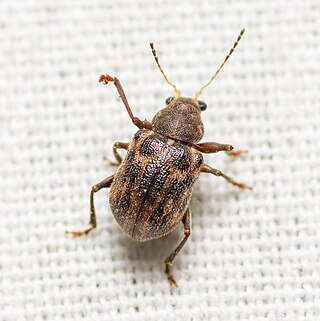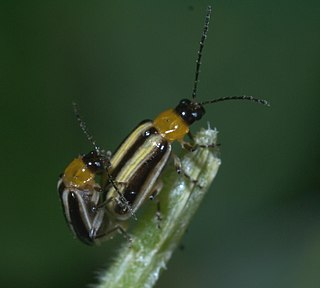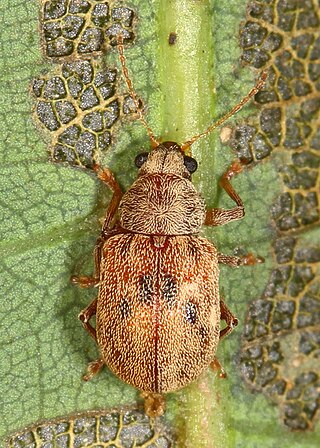
The Eumolpinae are a subfamily of the leaf beetles, or Chrysomelidae. It is one of the largest subfamilies of leaf beetles, including more than 500 genera and 7000 species. They are oval, and convex in form, and measure up to 10 mm in size. Typical coloration for this subfamily of beetles ranges from bright yellow to dark red. Many species are iridescent or brilliantly metallic blue or green in appearance.

Xanthonia is a genus of leaf beetles in the subfamily Eumolpinae. It is distributed in North and Central America, and in East, Southeast and South Asia.

Platycorynus is a genus of leaf beetles in the subfamily Eumolpinae. It is distributed in Africa and Asia.

The Spilopyrinae are a small subfamily of the leaf beetles, or Chrysomelidae. They occur in Australia, New Guinea, New Caledonia and Chile. They were formerly considered a tribe of the subfamily Eumolpinae. The group was elevated to subfamily rank by C. A. M. Reid in 2000. However, some authors have criticised this placement, preferring to retain them within the Eumolpinae.
Colaspoides is a genus of leaf beetles in the subfamily Eumolpinae. It is one of the largest genera in the subfamily, containing over 260 species worldwide. It is an extant genus but there is at least one species, C. eocenicus, found in Baltic amber from the Upper Eocene of Russia, and the genus has also been reported from the Miocene of the Dominican Republic.

Macrocoma is a genus of leaf beetles in the subfamily Eumolpinae. It contains about 100 species, which are found in tropical Africa, around the Mediterranean, on the Canary Islands, in western and central Asia, and in India.

Neofidia is a genus of leaf beetles in the subfamily Eumolpinae. It is distributed in North and Central America. There are 24 species recognised in Neofidia.
Neofidia clematis is a species of leaf beetle. It is known from southernmost Texas to central Veracruz, Mexico, east of the Sierra Madre Oriental. It was first described by the American entomologist Charles Frederic August Schaeffer in 1904. Two series of this species from Texas were collected from Cissus incisa, a species in the grape family (Vitaceae).

Eumolpini is a tribe of leaf beetles in the subfamily Eumolpinae. It is the largest tribe in the subfamily, with approximately 170 genera found worldwide. Members of the tribe almost always have a longitudinal median groove on the pygidium, which possibly helps to keep the elytra locked at rest. They also generally have a subglabrous body, as well as appendiculate pretarsal claws.

Luperini is a tribe of skeletonizing leaf beetles in the family Chrysomelidae. There are more than 30 genera and 500 described species in Luperini.

Glyptoscelis is a genus of leaf beetles in the subfamily Eumolpinae. There are 38 species of Glyptoscelis described from North, Central and South America. There are also three species of Glyptoscelis known from the West Indies, though they are wrongly placed in the genus. In addition, a single species was described from Hunan, China in 2021.

Demotina is a genus of leaf beetles in the subfamily Eumolpinae. There are over 50 described species in Demotina. The genus is native to Asia, Australia and Oceania, though one species is an adventive species in the southeastern United States in North America. Some species are known to be parthenogenetic.

Typophorini is a tribe of leaf beetles in the subfamily Eumolpinae. The tribe contains approximately 100 genera, which are found worldwide. Members of the tribe are mainly characterized by notches on the tibiae of the middle and hind legs, which are sometimes referred to as antenna cleaners. They also generally have a subglabrous body, as well as bifid pretarsal claws.
Pagria is a genus of leaf beetles in the subfamily Eumolpinae. It is known from Africa, Asia and Australia.
Aoria is a genus of leaf beetles in the subfamily Eumolpinae. Members of the genus are distributed in East and Southeast Asia. Food plants are known for only a few species, all of which were recorded from Vitaceae.

Fidia is a genus of leaf beetles in the subfamily Eumolpinae. It is distributed in East Asia, Southeast Asia and Africa.
Callisina is a genus of leaf beetles in the subfamily Eumolpinae. It is distributed in Asia.
Heterotrichus is a genus of leaf beetles in the subfamily Eumolpinae. It is distributed in Southeast Asia and Southern China.

Euryopini is a tribe of leaf beetles in the subfamily Eumolpinae.













